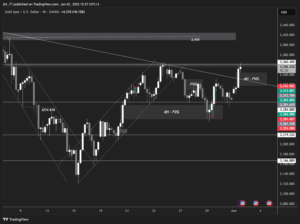Gold prices are edging higher in today’s trading session, on track for a second weekly gain, as traders await US employment data to gauge the path of potential Federal Reserve interest rate cuts.On the other hand, the US dollar is heading for a weekly decline, making dollar-denominated bullion more attractive to buyers from other currency holders. Economic data released on Wednesday, including the ISM services PMI and ADP employment report, pointed to a slowdown in the US economy. A separate report showed an increase in US initial jobless claims last week. All eyes are now on the US non-farm payrolls report due at 15:30 Riyadh time If the data reveals a slowdown in US job creation, “I expect investors to start pricing in a higher probability of a September rate cut from the Fed, which could push gold back above $2,400,” said Edward Moya, senior analyst at OANDA.Traders currently see a roughly 73% probability of a Federal rate cut in September, according to the Fed Funds futures tool available on Investing.com Arabic.Lower interest rates reduce the opportunity cost of holding gold, which does not yield a return.Spot gold is up 0.31% at $2,364 an ounce. The metal is up about 1% so far this week. On the other hand, the dollar index is down around 104.687.
Other metals
- Silver is up 0.5% in spot trading to $30.56 and on track for its best week since May 17.
- Platinum is down 0.3% to $999.64.
- Palladium is up 0.5% to $1,022.25 and on track for its third weekly gain.
Job Data Could Give Fed an Opening to Cut Rates Soon
With growing evidence that the US labor market is slowing, the June non-farm payrolls report takes on added significance.Total employment so far in 2024 is 1.24 million jobs, down about 50,000 jobs per month from the same period last year. Economists expect the report, due out in a few hours at 15:30 Riyadh time, to show growth of 191,000 jobs, down from 272,000 jobs reported in May. Historically, the pace of job gains remains strong. But there are signs of broader economic weakness ahead.
Unemployment Rate
This report comes at a time of greater uncertainty about the economic landscape than there was a few months ago. “Specifically, I’m thinking more about the unemployment rate, which has been trending slowly higher.” The unemployment rate rose to 4% in May, the first time it has hit that threshold since January 2022, up from 3.7% a year ago. Forecasts expect the rate to remain at that level.Under normal circumstances, a 4% unemployment rate might be cause for celebration, not concern. However, what is catching the attention of some economists is the comparison of the rate now to where it was a year ago. The May rate was 0.5 percentage point higher than its 12-month low of 3.5% in July 2023, which could trigger a recession indicator called the Stock-Watson rule.
The rule has consistently shown that when the average unemployment rate over three months exceeds its 12-month low by half a percentage point, the economy enters a recession. While there is little data to suggest a recession is imminent, the unemployment trend is generating some interest.”If the unemployment rate is doing what it’s been doing lately here, where it’s been rising very slowly, I don’t think it means we’re in a whole lot of danger of triggering the Stock-Watson rule or any kind of unemployment rate-led recession,” said Benker. “But the probability of that has gone up, even though that’s not the most likely outcome at the moment.”The economy has slowed in the first half of 2024. First-quarter GDP growth was measured at an annualized pace of 1.4%.
Average Wages
Concerns about inflation persist, which could lead to the Federal Reserve waiting longer before cutting interest rates. In addition to the main unemployment and employment figures, market participants and economists will be watching a number of other key indicators. Another area of concern has been the discrepancy between the number of non-farm jobs, as taken from the establishments participating in the Bureau of Labor Statistics survey, and the number of households with people reporting that they are employed. While the establishment survey showed employment growth of about 2.8 million over the past 12 months, the number of households, which is used to calculate the unemployment rate, rose by only 376,000.
Economists generally consider the establishment survey to be more reliable and less volatile because it includes a larger sample size, but the discrepancy has attracted some attention. In addition, hours worked and average hourly earnings will receive some attention as measures of inflation. Expectations are for a 0.3% monthly increase in wages and a 3.9% year-over-year increase. If expectations hold, this would be the first time the annual increase has fallen below 4% since June 2021.
Oil’s rally continues, prices heading for fourth straight week of gains
Oil prices fell during trading today, Friday, but are on track for their fourth straight week of gains and are nearing their highest levels since late April, driven by hopes of strong summer fuel demand and some supply concerns. Brent crude futures, which have risen 7% over the past four weeks, fell 31 cents, or 0.4%, to $87.12 a barrel. U.S. West Texas Intermediate (WTI) crude futures, which have risen 9% over the past four weeks, traded at $83.70 a barrel, down 18 cents, or 0.2%, from Wednesday’s close. With the U.S. market closed on Thursday for the Fourth of July holiday, trading was light and there was no settlement for WTI.Oil has rallied this week on expectations of strong summer fuel demand in the United States, the world’s largest oil consumer.
Key data affecting prices
On the other hand, the U.S. Energy Information Administration (EIA) reported a large draw of 12.2 million barrels in inventories last week, compared to analyst expectations of a 700,000-barrel draw. U.S. data on Wednesday showed that initial jobless claims rose last week while the number of unemployed also increased, which analysts said could prompt the Federal Reserve to cut interest rates sooner and support oil markets. On the supply side, Reuters reported on Thursday that Russian oil producers Rosneft and Lukoil will sharply cut oil exports from the Black Sea port of Novorossiysk in July.Meanwhile, Saudi Aramco (TADAWUL:2222) cut the price of its main Arab Light crude that it will sell to Asia in August to $1.80 a barrel above the average of Oman/Dubai, highlighting the pressure OPEC producers face as non-OPEC supply grows. Analysts said traders were also watching the war in Gaza and the elections in France and the UK.
Disclaimer: This article is not investment advice or an investment recommendation and should not be considered as such. The information above is not an invitation to trade and it does not guarantee or predict future performance. The investor is solely responsible for the risk of their decisions. The analysis and commentary presented do not include any consideration of your personal investment objectives, financial circumstances, or needs.





